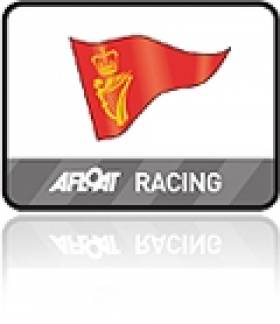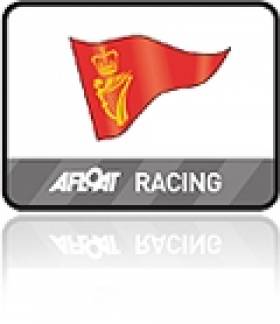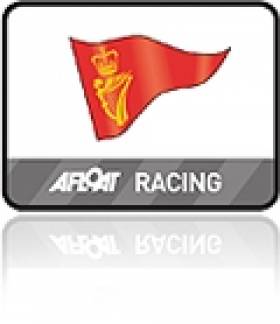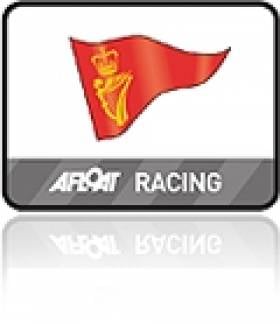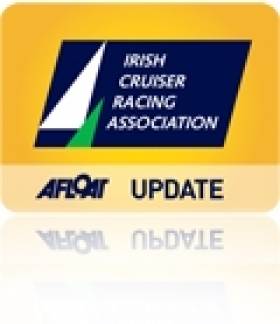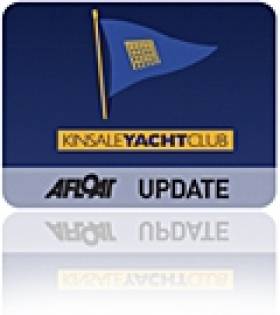Displaying items by tag: RCYC
Royal Cork Move up to Seventh in New York
Royal Cork Yacht Club is seventh overall after scoring an impressive third place in yesterday's race nine of the New York Invitational Cup. The Anthony O'Leary skippered yacht moved from tenth to seventh after scores of 3 and 12 in the penultimate day of the competition yesterday. The Crosshaven crew is five points behind sixth place Japan, a team that have consistently held an advantage over the Irish crew this week.
The New York Chamber of Commerce could not have arranged a more spectacular day for the 22 competing yacht club teams, representing 16 nations from six continents, than what was delivered today after a cold front that passed through the area overnight left behind a classic New England fall day to tantalize competitors at the 2011 New York Yacht Club Invitational Cup presented by Rolex. And after sailing eight races over three days on courses set north of Newport's Pell Bridge, with the breeze from the north-northwest, and an ebb tide, the race committee made the decision to send the competitors out of the now-familiar Narragansett Bay to Rhode Island Sound for two races on the penultimate day of the series.

Royal Cork YC's entry in the New York Cup skippered by Anthony O'Leary with tactics from son Nicholas Photo: Rolex/Kurt Arrigo
Remarkably, the first race of the day saw yet another yacht club team winning a race. Eastern Yacht Club became the ninth race winner, in nine races, when they took over the lead early in the race and held it all the way to the finish line.
"It was a good one," said Bill Lynn, helm of the Eastern Yacht Club team of the race as he explained that the EYC sailors liked the conditions today. "I think we're fast , but I don't think we're the fastest boat here, so I think getting out into some shifty, variable breeze with not perfectly flat water, suits our style in these boats a little better. We finally got a great start, which is kind of nice. It was probably our best start of the series so far, and then we just were patient. When we came off the windward end [of the starting line] and tacked onto port there were an awful lot of boats on port way up inside us. It looked grim there for a while. But we were going to stick to our guns and wait it out. And we did, and the righty finally came in at the end and got us around the mark in third and then after that it was playing the shifts [to stay at the top]."
When Lynn's team got through the first gate, they split with the Royal Yacht Squadron. "Fortunately we sent them around the wrong gate and we went around the right gate. When the breeze shifted back left we were crossing them. After we went through the gate and started going back upwind it got super windy, our gage was showing low 20s, and it stayed that way for the rest of the race. When it [the breeze] came smoking back in half-way through, that wasn't in anybody's forecast."
Lynn went on to explain that in a northwest breeze, you have to sail your own race and not worry too much about the other boats. "You almost have to pretend there are no other boats on the course. It's not about winning every race in a northwester, its about not blowing one." For race two, Lynn characterized Eastern's start as good, but in the wrong place on the line. They would go on to finish sixth, and now have 82 points on the scoreboard to stand fifth overall, while tied on points with Newport Harbor Yacht Club which is currently fourth.
For the second day in a row, the final race of the day has been won by the Clube Naval de Cascais (CNC) from Portugal, making them the first team in the 10 races to repeat as a winner. At the helm of CNC is Patrick Monteiro de Barros, whose varied sailing resume includes representing his country at the Olympic Games (twice), as well as circumnavigating the globe (twice). CNC placed 21st in the earlier race today, and with 128 points lies 16th overall.
It would certainly seem that the artic air from home brought additional good fortune for Royal Canadian Yacht Club (RCYC), as they maintained their grip on the top-position in the overall standings. With finishes of 6-11 today, they not only have 46 points but also have increased the spread to 10 points over New York Yacht Club which has 56.
Annapolis Yacht Club has moved up to third overall on 68 points after finishing 4-2 today. Tactician John Torgerson compared the flukey conditions the AYC team is used to in Annapolis with what they saw today on Rhode Island Sound. "It was super-shifty for a while and we like that," said Torgerson. "We had a good idea of what we were going to do off the start and we executed it. For the first race it was light at the start. We saw as little as nine [knots] to as much as 22, it was a huge range. You just had to be able to shift gears. We have guys that are really good at figuring it out." AYC's strategy for the final day of racing is to "just go out and sail" and hope that the two teams above and below them take each other out.
The eleventh and final race of the series will be held tomorrow, Saturday, September 17, and is scheduled for 1100. It will be preceded by the fleet parading through Newport harbor at 0900, with competitors leaving NYYC's Harbour Court at approximately 0830. The winner of the 2011 New York Yacht Club Invitational Cup presented by Rolex will be confirmed at the conclusion of racing.
Royal Cork Autumn League Entry fee Reduced to €90
Cavatina is White Sail Winner
The breeze came from a Westerly direction at 6 to 10 knots. The start was about 2 hours after high water. It was a gentle evening sail. The Race Officer Jim Sheeran managed to get everybody over the finish line despite the dying breeze.
Results Summary:
1st in White Sail IRC Ian Hickey's Granada 38 "Cavatina"
1st in White Sail Echo Micheal Lynch's Sun Odyssey 32i "Lady T"
1st in Class 3 IRC & Echo Jimmy Nyhan & Maritta Buwalda's 1/4 Tonner "Outrigger"
1st in Class 2 IRC & Echo Denis Coleman's Corby 25 "Thunderbird"
1st in Class 1 IRC & Echo Donal O'Leary's X35 "D-Tox"
Sun Shines for RCYC Thursday Racing
The breeze was coming from the North 8 to 15 knots. Full main and a light No.1. The start was 3 hours after low water. Because it was such a nice evening the Race Officer Ger Coakley threatened to send us to the Pollock Rock Buoy, which is a few miles Southeast of Roches Point. But thankfully he refrained. Instead he gave us an excellent course (No. 65). The course gave us all points of sailing including gybes. Some of us were not as good as others, but it gave us an excellent night of sailing.
The highlight of the evening in Cork Harbour was the successful rescue of the three people on a fishing boat on fire. Well done to all involved in the rescue.
Ian Hickey's Granada 38 "Cavatina" in White Sail got the number 1 slot in IRC & Echo. In Class 3 IRC it went to Jimmy Nyhan & Maritta Buwalda's 1/4 tonner "Outrigger" and in Class 3 Echo Tom & Cormac MacSweeney's Sigma 33 "Seascapes" did the trick. In Class 2 it was Leonard Donnery's Nicholson 33 "No Gnomes" that came 1st in IRC & 1st in Echo and in Class 1 the honours went to the J109 "Jelly Baby" Ian Nagle & Paul O'Malley and in Class One Echo it went to Derry & Hilda Good's X362 Sport "Exhale"
Dillon's Silk Breeze in Top Form in Cork Harbour IRC
The breeze was coming from the South West at about 10 knots. Full mains and a light No.1 for the seond race of the Timberland league. The start was an hour and a half after high water. So the spring tide made tactics more interesting. The Race Officers, once again set an excellent course. It was a clean start for everyone with a short beat from Corkbeg to the Cage which we left to port. We then reached out to No.3 and then another beat out to W2. It was then a bear away set for a Spinnaker up the harbour leaving No.6 to port on the way to No.5 otherwise known as Dognose. Short beat once again to the Cage with another bear away set to No.9 After that we had another beat back to Dognose and a short beat then to the finish. It was a proper summer evening race thanks to the Race Officers and the Weather Gods!
Ernie Dillon's "Silk Breeze" in White Sail got the number 1 slot in IRC and 2nd in Echo. In Class 3 it went to Jimmy Nyhan & Maritta Buwalda's 1/4 tonner "Outrigger" in both IRC & Echo, in Class 2 it was Kieran & Liz O'Briens MG335 "Magnet" that came 1st in IRC & 2nd in Echo and in Class 1 the honours went to the Corby "Gloves Off" Kieran Twomey.
Tingle's 'Alpaca' Wins Class Two of Union Chandlery League
There were concentrated faces last night in Cork Harbour where the Royal Cork fleet had a windy evening of racing in the Union Chandlery June League.
Brian Heffernan's Dufour 365 Aisling was first in the in White Sail division. Class 3 went to Jimmy Nyhan and Maritta Buwalda in their Quarter Tonner Outrigger. Class 2 winners were Paul and Deirdre Tingle's First 31.7 "Alpaca" and in Class one the honours went to Robert O'Leary in his modified 1720 Antix Beag.
Concentration this morning now turns to the first race of the ICRA National Championships being held in Crosshaven.
The wind was southwesterly at about 20 knots gusting to 30. Race officers set an excellent course (No.70). It was a clean start at the top of the tide, with a beat to the cage.
Those that kept to the south made the right call. It was then a run to No.7 where we gybed and headed for No.13 Some were brave enough to carry spinnakers with some interesting results both good and not so good. A number of Irish Naval ships at anchor off Spike Island.
After No.13 the fleet had a fetch back to No.9 and then a beat back to Cage. With the tide now ebbing it paid to go down the middle. We rounded Cage once again with a run back to No.7 more spinnakers up this time. After rounding No.7 the fleet had a nice beat home.
Cruiser Racers Head for Royal Cork
Simon McGibney of WIORA confirmed there are already at least 15 boats interested in travelling to the event to join with the Cork, Kinsale and East coast boats. There is also the tantalising prospect of the fleet being joined by no less than ten quarter tonners from the UK who also plan to sail in the Sovereign's Cup at Kinsale the following week. Most of these British boats are crewed by professionals and will race with the Irish Class three fleet. They will, however, be scored separately and will receive a separate trophy.
Sailing with the Quarter Ton fleet will be Anchor Challenge, beautifully restored and modified by former owner Peter Morton, and now in the ownership of Eamon Rohan. At the weekend our spy spotted an all white gleaming boat wending its way up the Kinsale Road and wondered could this possibly have been Anchor Challenge and, if so, will we see a battle between the all black Tiger and the all white newcomer??
For the duration of the ICRA National Championships there will be subsidised launching at Ringaskiddy for all trailerable boats. In addition a very attractive accommodation package has been arranged for all ICRA competitors at the Carrigaline Court Hotel. They are offering three nights B/B plus one evening dinner from Thursday to Saturday and free B/B for Sunday night at €129 per person sharing.
A crew list has been set up by RCYC for skippers wishing to acquire crews with local knowledge and Race Officers for the event will be the hugely experienced Peter Crowley and Richard Leonard.
ICRA Commodore Barry Rose was delighted to inform the meeting that Yacht Designer Mark Mills has joined the ICRA committee where his expertise and wide knowledge will be greatly appreciated. Mark gave a most interesting report on recent developments re racing matters. One item referred to the fact that boats with bulb keels will now be more severely rated and another item of interest is discussion going on with regard to changing the rating bands for the 2012 Commodores Cup. It is believed there is a move afoot to lower the bands i.e. the current middle rated boat may be the big boat for the 2012 event.
Thirty Enjoy Kinsale's Frostbite Finale
Conditions for the final day of the ASM-Marine Frostbite League at Kinsale Yacht Club on Sunday could not have been a more inviting finale for the thirty plus sailors competing in the Laser, Squib and Mixed Dinghy Fleets. Despite losing two of the six week series due to the weather, the last day of the season brought welcome sunshine accompanied by a fresh Force 4 North to North-Westerly breeze, gusting Force 5 at times. Three windward-leeward races were completed which brought the total race number to eleven, with two discards applying. The constantly shifting Northerly breeze, which tracked slowly westwards was the predominate feature in all three races, with an ebb tide having effect to the right hand side of the coarse.
Dara O'Shea (KYC) with another gritty performance in the Laser 4.7 fleet, managed this week to overhaul the league leader Cian Byrne (KYC/RCYC). Leaving it to the final race and with both sailors on nineteen points, Dara grasped the top spot as he fought off his rivals and eventually took line honours and the Laser 4.7 League title. Cian untypically finished fourth but nevertheless secured second place overall, just two points behind. Darragh O'Sullivan had an excellent day's racing with a win and two seconds which pulled him into third place overall, just ahead of Conor Murphy (KYC) who finished on the same points total but one place behind in the final race.
Proving once again that consistency is the key to success in the Frostbite League, Eoghan Cudmore (KYC) with a fifth, third and a second in the Radial Fleet managed to hold off the challenge for the top spot from last year's winner Sean Murphy (KYC) who scored two thirds and a fourth. With the second best results of the day, Colm O'Regan (KYC) scoring two seconds and a fourth, moved up to third place overall. Despite an excellent run of results with three wins on the final day Thomas Chaix (KYC) with insufficient points accrued could not make an impact on the final order.
In the Laser Standard Class Rob Howe (RCYC) continued his outstanding form with a further second place and two firsts bringing his overall total to an unassailable eleven points, fourteen points ahead of his nearest rival Paul O'Sullivan of Monkstown. Scoring two thirds and a second, O'Sullivan's consistent form paid off bringing him into second place overall. David Kenefick (RCYC) who had closely pursued the leader throughout the series, dropped to third place overall as he did not compete on the day.
Seldom conceding line honours Marcus Hutchinson and Ben Fusco (KYC) in the Squib Class went into the final day leading comfortably by eight points. Two wins later and a final second easily secured the league title and are now the new holders of the Bruce Mathews Squib Trophy. In a repeat of last year Paul McCarthy (KYC) finished strongly with two seconds and a win in the final race. These results elevated him from fourth place overall into the prize winning second position. Victor Fusco and Ruth Ennis (KYC) with a final third, fourth and seventh subsequently slipped one place to claim the third prize overall.
In the Mixed Dinghy Class, despite conceding line honours in all three races Brian Jones and Gary Frost (MBSC) in their International 505 finished the series as the lead boat four points comfortably ahead. The RS Feva of David Marshall and Rob Scandrett (RCYC) closed on a high note as they took advantage with three win ASM-Marine KYC Frostbite League - Sunday 27th Feb, 2011.
Conditions for the final day of the ASM-Marine Frostbite League at Kinsale Yacht Club on Sunday could not have been a more inviting finale for the thirty plus sailors competing in the Laser, Squib and Mixed Dinghy Fleets. Despite losing two of the six week series due to the weather, the last day of the season brought welcome sunshine accompanied by a fresh Force 4 North to North-Westerly breeze, gusting Force 5 at times. Three windward-leeward races were completed which brought the total race number to eleven, with two discards applying. The constantly shifting Northerly breeze, which tracked slowly westwards was the predominate feature in all three races, with an ebb tide having effect to the right hand side of the coarse.
Dara O'Shea (KYC) with another gritty performance in the Laser 4.7 fleet, managed this week to overhaul the league leader Cian Byrne (KYC/RCYC). Leaving it to the final race and with both sailors on nineteen points, Dara grasped the top spot as he fought off his rivals and eventually took line honours and the Laser 4.7 League title. Cian untypically finished fourth but nevertheless secured second place overall, just two points behind. Darragh O'Sullivan had an excellent day's racing with a win and two seconds which pulled him into third place overall, just ahead of Conor Murphy (KYC) who finished on the same points total but one place behind in the final race.
Proving once again that consistency is the key to success in the Frostbite League, Eoghan Cudmore (KYC) with a fifth, third and a second in the Radial Fleet managed to hold off the challenge for the top spot from last year's winner Sean Murphy (KYC) who scored two thirds and a fourth. With the second best results of the day, Colm O'Regan (KYC) scoring two seconds and a fourth, moved up to third place overall. Despite an excellent run of results with three wins on the final day Thomas Chaix (KYC) with insufficient points accrued could not make an impact on the final order.
In the Laser Standard Class Rob Howe (RCYC) continued his outstanding form with a further second place and two firsts bringing his overall total to an unassailable eleven points, fourteen points ahead of his nearest rival Paul O'Sullivan of Monkstown. Scoring two thirds and a second, O'Sullivan's consistent form paid off bringing him into second place overall. David Kenefick (RCYC) who had closely pursued the leader throughout the series, dropped to third place overall as he did not compete on the day.
Seldom conceding line honours Marcus Hutchinson and Ben Fusco (KYC) in the Squib Class went into the final day leading comfortably by eight points. Two wins later and a final second easily secured the league title and are now the new holders of the Bruce Mathews Squib Trophy. In a repeat of last year Paul McCarthy (KYC) finished strongly with two seconds and a win in the final race. These results elevated him from fourth place overall into the prize winning second position. Victor Fusco and Ruth Ennis (KYC) with a final third, fourth and seventh subsequently slipped one place to claim the third prize overall.
In the Mixed Dinghy Class, despite conceding line honours in all three races Brian Jones and Gary Frost (MBSC) in their International 505 finished the series as the lead boat four points comfortably ahead. The RS Feva of David Marshall and Rob Scandrett (RCYC) closed on a high note as they took advantage with three wins and claimed the second prize overall. Finishing third on the day and third overall in the series was the Feva of Fiona Lynch and Sofie Kelleher.
At the Prize Giving, Alice Kingston KYC Commodore, congratulated the deserving winners and thanked all the sailors for their efforts. Special thanks went to PRO Bruce Mathews for his dedicated support, the Organisers, the Sponsor ASM-Marine and all those who had helped both on and off the water to make this annual event such a success. Cameron Good KYC Vice-Commodore presented the prizes and June Matthews presented the Bruce Matthews Trophies for the best performances in the Laser Radial and Squib Classes won by Eoghan Cudmore and Marcus Hutchinson respectively. The inaugural Laser 4.7 'Destiny' Trophy was presented to Dara O'Shea.
- ASMMarine
- Kinsale
- yacht
- Club
- Frostbite
- Dara O'Shea
- Cian Byrne
- Darragh O'Sullivan
- Conor Murphy
- Eoghan Cudmore
- Colm O'Regan
- Sean Murphy
- Ben Fusco
- Marcus Hutchinson
- squib
- Paul McCarthy
- Ennis
- Ruth
- Dinghy
- Cameron Good
- Ruth Ennis
- Fiona Lynch
- Sofie Kelleher
- David Marshall
- Laser
- David Kenefick
- RCYC
- Royal Cork
Half Tonners Head for Cowes in 2011
The local representative of the Half Ton Class, Richard Hollis, owner of the X-95 Crackajax (which is a production half tonner), is also Rear Commodore RCYC. Richard has agreed to co-ordinate the event, with active support of the Half Ton Class Europe.
By announcing the date & venue of the next event at an early stage, the Half Ton Class Europe and the RCYC hope that the participating teams are given enough time to prepare their entry.
The Half Ton Class Europe would like to remind owners that the Class Spirit, well known to all the crews who have participated in one of the previous 4 Half Ton Classic Cups, will prevail in scrutinising applications to enter the event.
The basic definition of a Classic Half-tonner is a yacht which was designed and built as a prototype one-off 'half tonner' (or is a production boat derived from the same hull) under the IOR rule between 1st January 1967 and 31st December 1993, and was eligible to participate at the IOR Half Ton Cup during that period. No alterations shall have been made to the hull of the boat and rigid wing masts will not be tolerated. No outside assistance such as coach boats will be permitted during races and no more than (1) professional crew (ISAF Cat.1) will be permitted on any one boat.
The event will consist of 5 days of racing. The race officer will be asked to set windward-leeward races, Olympic triangles and "round the cans" races on the Solent as well as a 'long' offshore race: wind and weather permitting, this will be a 'Half Ton Round the Island' Race. Together with the inshore racing this should make the Half Ton Classic Cup 2011 a memorable event.
If you want to be kept updated about the event, please indicate your interest via the Class' mail address: bert.janssen [at] halftonclass-europe.net
Official Notice of Race to be published soon on:
www.halftonclass-europe.net
RCYC Called for New York Invitational
When its Invitational Cup comes around again in 2011, the New York Yacht Club will proudly fly the Irish tricolour among country flags of yacht clubs from around the world and the trademark green and gold colors of presenting sponsor Rolex. The club has determined its official list of invited yacht clubs for the biennial event, scheduled for September 10-17, 2011, and plans to build on the success of the inaugural NYYC Invitational Cup, which was held in September 2009 and hosted 19 teams from 14 nations. Among those teams are a returning squad from Royal Cork
“The essence of the regatta is to bring together Corinthian (amateur) yacht club teams in a competition that not only is tough and demanding but also levels the playing field.” said NYYC Commodore David K. Elwell Jr., explaining that the five-day regatta is sailed in chartered NYYC Swan 42s. Sails are supplied and rigs are equally tuned, allowing each club to demonstrate the skills of its top sailors.
"The response to and the outcome of the 2009 event were greater than we could ever have expected,” added Elwell. “Those yacht clubs returning have vowed to do so with a vengeance and many new clubs are joining the mix.”
The top finishers in 2009 offered automatic entry to the 2011 event are New York Yacht Club, Royal Canadian Yacht Club, Japan Sailing Federation, Nyländska Jaktklubben of Finland; Royal Cork Yacht Club of Ireland and Royal Bermuda Yacht Club. In addition, Real Club Nautico Barcelona (Spain) and Royal Yacht Squadron (London, England) have been invited to return, while new yacht clubs Clube Naval de Cascais (Portugal), Cruising Yacht Club of Australia, late Clube do Rio de Janeiro (Brazil), Royal Cape Yacht Club (Cape Town, South Africa), Royal Sydney Yacht Squadron (Australia), Société Nautique de Saint Tropez (France), Yacht Club Argentino, and Yacht Club Punta Ala (Italy) are expected to accept first-time invitations.
Rounding out the fleet of 16 will be three additional U.S. teams that will be determined by the outcome of this year’s 24-club U.S. Qualifying Series (scheduled for September 7-11 at the NYYC in Newport), and up to twelve additional international yacht clubs on the condition that they bring their own boats for competition.
The worldwide fleet of NYYC Swan 42s currently consists of 46 boats, 23 of which are owned by New York Yacht Club members. The NYYC Swan 42s are unique one-design racer/cruisers created by the NYYC in partnership with Nautor’s Swan to boost Corinthian sailing and promote increased competitiveness within an owner-driver and amateur sailing framework.
“The event promises to showcase the finest amateur sailors in the world,” said returning Event Chair John Mendez, noting that, as evidenced by the teams formed in 2009, there are plenty of big names in sailing who do not or no longer sail as professionals. “The opportunity to race at such a high level of competition has encouraged many clubs to seek an invitation, for where else can they take their best club racers and compete against national and international champions, even America’s Cup legends, on an equal basis? For many, the chance to race in Newport alone is a once-in-a-lifetime experience, and to socialize in such an electric atmosphere after a day of hard racing is simply icing added to the cake.”
Racing in the NYYC Invitational Cup presented by Rolex will take place on Narragansett Bay and Rhode Island Sound, the same waters where the New York Yacht Club hosted the America’s Cup – a trophy it first won in 1851 – from 1930-1983. Prizes will be awarded to the top three teams, and the winning yacht club's name will be engraved on the NYYC Invitational Cup that is permanently displayed at NYYC’s 44th Street Clubhouse in Manhattan.
In addition to Rolex, Sperry Top-Sider is also a sponsor of the 2011 event.



























